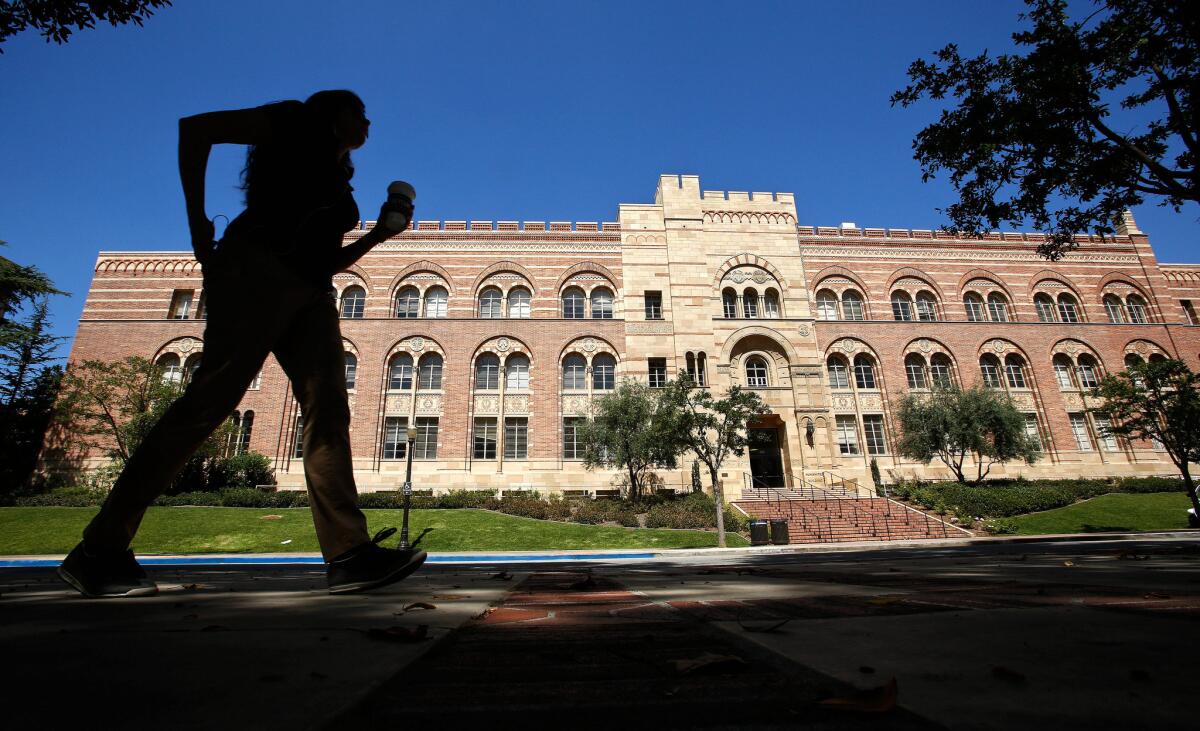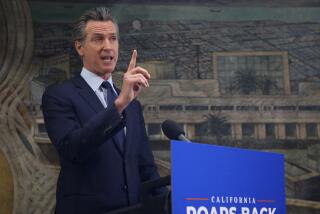Newsom rejects tuition increases for UC and Cal State but proposes more funding than expected

Gov. Gavin Newsom on Friday rejected tuition increases this fall at the University of California and California State University but provided more higher education funds in his 2021-22 proposed budget than some campus leaders had expected.
“We do not believe it’s time for tuition increases and fee increases,” Newsom said in unveiling his budget proposal at a Sacramento briefing. “And we do believe it’s time to invest more in student aid across the spectrum. And that’s exactly what this budget proposes.”
Newsom’s proposal provides a 3% increase in base funding for UC and Cal State, which would help the two public university systems recover from substantial financial losses and added expenses triggered by the COVID-19 pandemic. Both systems were hit with state budget cuts of about $300 million each, massive losses in revenue from housing and dining, added expenses for technology as campuses shifted to online learning, and additional outlays for coronavirus testing and tracing, cleaning and protective equipment.
The proposed increase does not cover all of those losses or come close to reaching the level of funding that the systems had asked for. Moreover, Newsom said the increases were being proposed with the “expectation” that the UC and Cal State systems do not raise tuition or fees.
At the UC system, senior leaders at the majority of undergraduate campuses told The Times last month that they believed it was time to begin talking about a possible tuition increase to ease their financial straits due to the pandemic, continued rising costs and flat tuition rates for most of the last decade.
But Newsom noted that the second stimulus bill passed last month by Congress could provide an additional $2.9 billion to California colleges. An analysis of that legislation by the American Council on Education found that the federal funds could amount to $73 million at Cal State Northridge, for instance, and more than $50 million at UCLA, UC Irvine, UC San Diego and UC Davis.
In a statement, UC Board of Regents Chairman John A. Pérez and UC President Michael V. Drake thanked Newsom for what they called “critical investments in UC students and California’s future, especially given the fiscal uncertainty during COVID-19.”
Cal State Chancellor Joseph I. Castro, who began his role this week, called Newsom’s budget proposal “a welcome reinvestment” and noted specifically the money for the graduation initiative, which Cal State leaders had been worried could be in jeopardy.
“The state’s investment in the CSU has led to greater access and record-levels of achievement for students under Graduation Initiative 2025, which in turn produces career-ready graduates in a timely manner,” Castro said in a statement.
That gratitude was echoed by Eloy Ortiz Oakley, who serves as both a UC regent and chancellor of the California Community Colleges system.
“The biggest issue for us going into this budget was student need,” he said, noting that many students in the system took fewer classes or dropped out altogether because they had to find ways to meet financial obligations at home.
Newsom’s proposal gives the UC system an increase of $136.3 million in ongoing general funds to cover core needs plus money for student access to technology and mental health services, medical education, immigrant legal services and firearms violence research. Another $225.3 million in one-time funding would help cover deferred maintenance, energy efficiency projects, emergency financial assistance for students and support for other programs, such as research in science and innovation.
The proposal fell far short of UC’s budget request of more than $500 million for ongoing funding — but it could have been worse, budget experts said.
“Given that revenues have come in substantially higher than had been originally forecast, it has allowed the state to provide more investments in UC, CSU and the community colleges than many of us had feared would have been the case,” said Hans Johnson, a higher education expert at the Public Policy Institute of California. “And while the total allocations in terms of increases for UC and CSU in particular are not as high as they might have had in their budget requests, they’re pretty substantial still.”
George Blumenthal, a former UC Santa Cruz chancellor who now heads the UC Berkeley Center for Studies in Higher Education, said Newsom’s budget does not address the steady decline in per-pupil state support over decades — and is tying UC’s hands to raise more revenue by increasing tuition and fees.
Although the UC regents retain the sole authority to determine tuition rates, Newsom — and former Gov. Jerry Brown before him — tied the state funding increases to a maintenance of current tuition rates.
“This is not a tragic or horrible budget, but to the extent that it continues a long-term trend … and especially as the governor is saying, no tuition increases going forward, then I think it’s somewhat alarming in terms of the future efficacy of the educational experience,” Blumenthal said. “How can that have any effect other than to decrease the quality of the university?”
At the Cal State system, Newsom proposed an additional $144.5 million in recurring funding, including money for the system’s flagship Graduation Initiative, a 10-year campaign to increase graduation rates and close equity gaps, and $30 million to support students’ basic needs of food and housing, access to technology and mental health services.
The money represents about half of the $299 million in ongoing funding for the Cal State system that was cut last year because of the recession and state budget deficit.
Newsom also proposed $225 million in one-time funding for Cal State. The majority of that will go to deferred maintenance across campuses, but the money also includes $30 million for emergency financial assistance grants to students and $10 million for faculty professional development, including in online instruction.
For both university systems, the funding would be granted “with the expectation” that they maintain undergraduate tuition and fee levels for 2021-22 and take steps to reduce equity gaps significantly.
Also, the systems would create a new “dual admission” pathway granting a guaranteed UC or Cal State seat to high school graduates who do not gain immediate freshman entry but would move over after they complete prescribed community college coursework needed for a transfer degree. By giving them conditional admission upfront, proponents say, students would be more likely to stay on the path to a four-year degree.
At the California Community Colleges, which serve some of the most financially vulnerable students in higher education and where enrollment in fall 2020 dropped by about 8%, Newsom’s proposal focused on emergency financial assistance and efforts to retain students who struggled financially or with online instruction.
The budget included $250 million for emergency financial assistance to students, $20 million to bolster retention and enrollment by engaging students who withdrew or who may be hesitant to enroll because of the pandemic, $100 million for food and housing needs, and $30 million for technology access and mental health resources.
There was also $35 million to support apprenticeships and other “work-based learning” programs for community college students and $30 million for professional development and distance learning.
More to Read
Sign up for Essential California
The most important California stories and recommendations in your inbox every morning.
You may occasionally receive promotional content from the Los Angeles Times.












